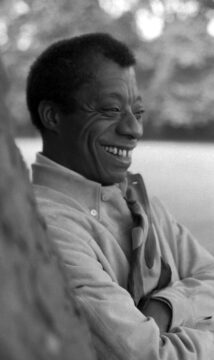Colm Tóibín at the NYRB:
 I read James Baldwin’s Go Tell It on the Mountain just after my eighteenth birthday, at a time when I presumed that my Catholic upbringing would soon mean little to me. During my first year at university, which I had just completed, I told no one that I had come close to joining a seminary. Some of my memories of almost having a vocation for the priesthood were embarrassing. I wished they belonged to someone else. But now my religious feelings had not merely ended; I hoped they had been effectively erased. Such feelings, I noticed, were mostly absent from the books I was reading, the films I was watching, the plays I was seeing, the conversations I was having.
I read James Baldwin’s Go Tell It on the Mountain just after my eighteenth birthday, at a time when I presumed that my Catholic upbringing would soon mean little to me. During my first year at university, which I had just completed, I told no one that I had come close to joining a seminary. Some of my memories of almost having a vocation for the priesthood were embarrassing. I wished they belonged to someone else. But now my religious feelings had not merely ended; I hoped they had been effectively erased. Such feelings, I noticed, were mostly absent from the books I was reading, the films I was watching, the plays I was seeing, the conversations I was having.
Even the religion in James Joyce’s A Portrait of the Artist as a Young Man seemed remote. Joyce himself—and Stephen Dedalus in the novel—had attended the same university where I was now studying, but the campus had moved to the Dublin suburbs; the new buildings were glass and steel, worlds away from the intimacy of Newman House in the center of Dublin where Joyce (and Stephen) had studied.
more here.
Enjoying the content on 3QD? Help keep us going by donating now.

 W
W B
B It must be dismal to come of age in an era so drenched in utility as ours. What was once called soul hunger is now relentlessly thwacked aside by engines of ever greater efficiency, from effective altruism to generative AI. Even the animating realms of art and sex appear to have contracted to the merely serviceable, functional, and fair-minded.
It must be dismal to come of age in an era so drenched in utility as ours. What was once called soul hunger is now relentlessly thwacked aside by engines of ever greater efficiency, from effective altruism to generative AI. Even the animating realms of art and sex appear to have contracted to the merely serviceable, functional, and fair-minded. Being rational necessarily involves engagement with probability. Given two possible courses of action, it can be rational to prefer the one that could possibly result in a worse outcome, if there’s also a substantial probability for an even better outcome. But one’s attitude toward risk — averse, tolerant, or even seeking — also matters. Do we work to avoid the worse possible outcome, even if there is potential for enormous reward? Nate Silver has long thought about probability and prediction, from sports to politics to professional poker. In his his new book
Being rational necessarily involves engagement with probability. Given two possible courses of action, it can be rational to prefer the one that could possibly result in a worse outcome, if there’s also a substantial probability for an even better outcome. But one’s attitude toward risk — averse, tolerant, or even seeking — also matters. Do we work to avoid the worse possible outcome, even if there is potential for enormous reward? Nate Silver has long thought about probability and prediction, from sports to politics to professional poker. In his his new book  Central to the Cold War between the United States and the Soviet Union was a rivalry to develop the technologies of the future. First came the race to deploy nuclear weapons on intercontinental missiles. Then came the space race. Then came US President Ronald Reagan’s “Star Wars” program, which seemed to launch a new race to build missile-defense systems. But it soon became clear that the Soviet economy had fallen decisively behind.
Central to the Cold War between the United States and the Soviet Union was a rivalry to develop the technologies of the future. First came the race to deploy nuclear weapons on intercontinental missiles. Then came the space race. Then came US President Ronald Reagan’s “Star Wars” program, which seemed to launch a new race to build missile-defense systems. But it soon became clear that the Soviet economy had fallen decisively behind. OVER THREE DAYS
OVER THREE DAYS Ever since Thomas Carlyle first launched his Letters and Speeches of Oliver Cromwell on the world in 1845, the Lord Protector’s published words have exercised an almost mesmeric hold on posterity. Overnight, they transformed a figure who had hitherto been a byword for villainy – was he not the killer of King Charles I? – into a hero for the new Victorian age: a God-fearing, class-transcending champion of ‘russet-coated captains’ who became Britain’s first non-royal head of state. His words resonated with a newly politically ascendant and morally earnest middle class. And in Hamo Thornycroft’s vast sculpture installed outside Westminster Hall in 1899, the Carlylean transformation of Oliver begun by the Letters and Speeches found its embodiment in bronze.
Ever since Thomas Carlyle first launched his Letters and Speeches of Oliver Cromwell on the world in 1845, the Lord Protector’s published words have exercised an almost mesmeric hold on posterity. Overnight, they transformed a figure who had hitherto been a byword for villainy – was he not the killer of King Charles I? – into a hero for the new Victorian age: a God-fearing, class-transcending champion of ‘russet-coated captains’ who became Britain’s first non-royal head of state. His words resonated with a newly politically ascendant and morally earnest middle class. And in Hamo Thornycroft’s vast sculpture installed outside Westminster Hall in 1899, the Carlylean transformation of Oliver begun by the Letters and Speeches found its embodiment in bronze. An age ‘clock’ based on some 200 proteins found in the blood can predict a person’s risk of developing 18 chronic illnesses, including
An age ‘clock’ based on some 200 proteins found in the blood can predict a person’s risk of developing 18 chronic illnesses, including 

 Three times a day my phone pings with a notification telling me that I have a new happiness survey to take. The survey, from
Three times a day my phone pings with a notification telling me that I have a new happiness survey to take. The survey, from  How could gaining knowledge amount to anything other than discovering what was already there? How could the truth of a statement or a theory be anything but its correspondence to facts that were fixed before we started investigating them?
How could gaining knowledge amount to anything other than discovering what was already there? How could the truth of a statement or a theory be anything but its correspondence to facts that were fixed before we started investigating them?